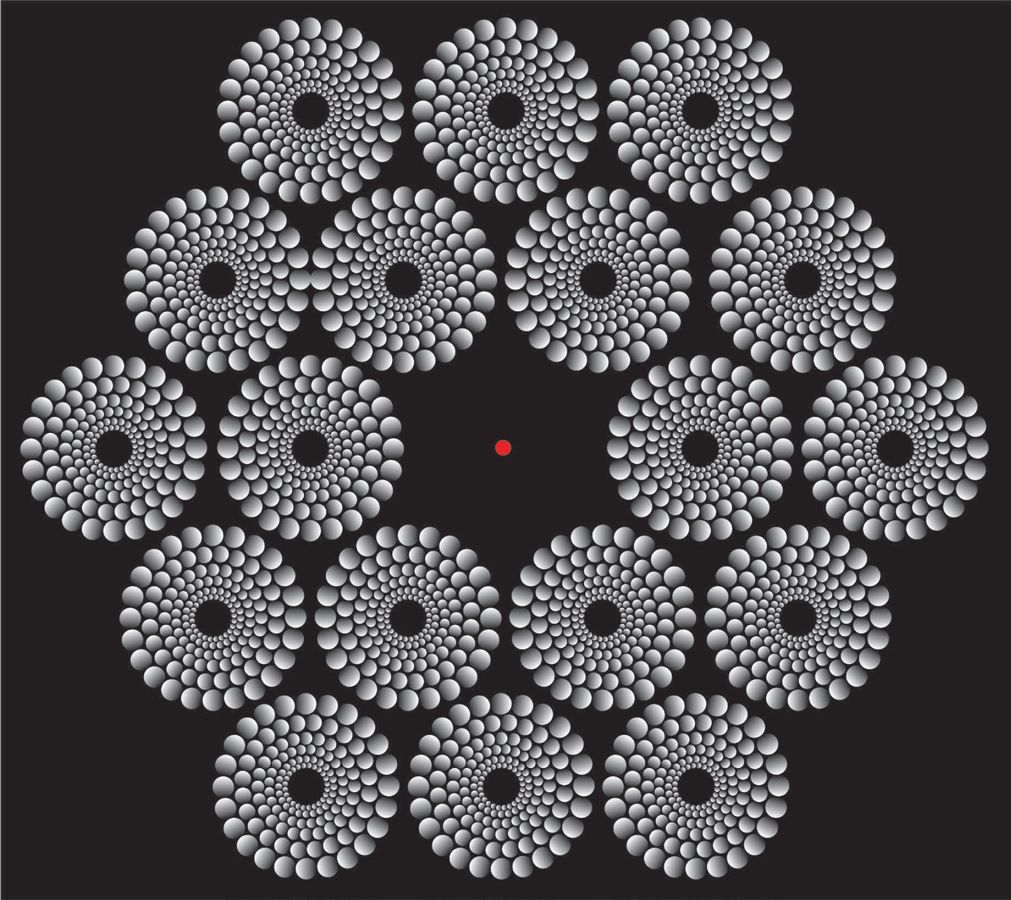
Every nervous system in nature has evolved to detect change. Static environments hold little interest and pose no threat to our survival, so our brains have learned to ignore them. Indicating change alone—as opposed to constantly signaling lack thereof—results in great metabolic savings for our bodies. Your brain represents only 2 percent of your total weight, but it uses more energy than any other organ, accounting for up to 20 percent of your body’s total. But even that much energy is not enough to process the vast amount of information that constantly bombards your senses. Of the many evolutionary shortcuts your nervous system has developed, a main one is to avoid bothering with things that don’t change.
In contrast, change—especially if sudden—is extremely stimulating to our senses, and we have evolved to detect it. Change could mean that … a predator is approaching! Or that prey is getting away! The downside is that, without change, we cannot perceive the world around us. Our brains turn off in the absence of variation. You may think that this is impossible—after all, if you sit still in a quiet room, your surroundings don’t just disappear. But the fact is that we can only see immobile objects because our eyes are always moving. Even when we think that our gaze is perfectly frozen, we still make constant microscopic eye movements, introducing the change we require to perceive reality.
Our need for motion in order to see—be it motion in the world, or our own eye movements—presents the visual system with an interesting challenge. How can you tell if it is the world that is moving, or your eyes? To get a sense of this problem, tap lightly and quickly on the outer corner of your upper eyelid, so that your eyeball moves back and forth a tiny bit. The visual world immediately becomes unstable and shaky. But if you were to move your eyes by the same amount voluntarily, the scene in front of you would appear perfectly steady. This indicates that the brain usually suppresses self-generated motion from eye movements, but it registers actual motion that occurs in the world. To enact this differential suppression, the brain must tell apart one kind of motion from the other. Previous studies had concluded that the primary visual cortex could not distinguish the motion of your eyes from motion in the world, but our own research has shown that the neural mechanisms needed to do so are already present at this early brain level. The perceptual distinction resulting from the underlying circuitry is often flawless, but certain repetitive visual patterns, such as the ones presented in this chapter, push the limits of our perception and make us think that the world is in motion—when only our eyes are moving.
BY JOHANNES ZANKER
ROYAL HOLLOWAY, UNIVERSITY OF LONDON, U.K.
2005 FINALIST
In the Spinning Disks Illusion, grayscale gradients in the shape of disks are arranged in concentric circles that seem to spin slowly, instead of appearing completely motionless—which they actually are! The illusion is caused by involuntary eye movements: each eye motion moves the image onto a new population of retinal photoreceptors. If you stare at the red central dot, carefully holding your eyes in place, the illusory motion will cease.
Look at the center of the left-hand image below and notice how the concentric green rings appear to fill with rapid illusory motion, as if millions of tiny cars were driving hell-bent for leather around a track. For almost two hundred years, artists, psychologists, and neuroscientists debated whether this type of striking illusory motion originates in the eye or in the brain; for almost two decades, the controversy centered on the motion perceived in a similar painting, called Enigma, created by Isia Leviant, an artist associated with the Op Art movement. Op Art started in the 1960s with the explicit intent to examine illusory perception. Our colleague Jorge Otero-Millan created this particular image as a reinterpretation of Leviant’s Enigma.

Does the illusion originate in the mind or in the eye? The evidence was conflicting until we found, in collaboration with Xoana Troncoso and Otero-Millan, that the illusory motion is significantly driven by microsaccades: small involuntary eye movements that occur when we fix our eyes on a target.
Some years ago, Susana noticed that the speed of illusory motion in Enigma was not immutable across time, but depended on how precisely she fixed her gaze. If she held her eyes very still while staring carefully at the center of the image, the motion seemed to decrease and would occasionally come to a full stop. Conversely, when she focused her eyes loosely, the movement sped up. Our previous research had shown that strictly focusing your eyes suppresses the production of microsaccades, with dramatic effects on visibility. It followed that microsaccades may drive the perception of Enigma’s illusory motion under normal, or loosely focused, fixation conditions.
To test this idea, we asked volunteers to stare steadily at a small spot at the center of an Enigma-like pattern while we tracked their eye movements. Subjects pressed a button whenever the motion appeared to slow down or stop and released the button whenever the motion sped up. As we predicted, microsaccades increased in frequency just before people saw faster motion, and became sparser just prior to the slowing or halting of the motion. The results, published in 2008, proved for the first time that this type of illusory motion starts in the eye. Otero-Millan’s Enigmatic Eye (right image on opposite page), also a tribute to Enigma, reflects the role of eye movements in the perception of the illusion.
The precise brain mechanisms that cause us to perceive the Enigma Illusion are still unknown. One possibility is that microsaccades—and perhaps other eye movements, too—produce small shifts in the geometric position of the peripheral areas of the image. These shifts may cause repeated contrast reversals that could create the illusion of motion. The neuroscientist Bevil Conway and his colleagues at Harvard Medical School demonstrated that pairs of static stimuli with different contrast levels can generate motion signals in visual cortex neurons. This phenomenon, in combination with eye movements, may explain the perception of illusory motion in many static patterns, including the Enigma Illusion.
THE ROTATING-TILTED-LINES ILLUSION
This illusion, developed by the vision scientists Simone Gori and Kai Hamburger, is a variation on Enigma. To experience the illusion, move your head forward and backward as you fixate in the central area (or, alternatively, hold your head still and move the page). As you approach the image, notice that the radial lines appear to rotate counterclockwise. As you move away from the image, the lines appear to rotate clockwise. Vision scientists have shown that illusory motion activates brain areas that are also activated by real motion. This could help explain why our perception of illusory motion is qualitatively similar to our perception of real motion.
BY GIANNI SARCONE, COURTNEY SMITH, AND MARIE-JO WAEBER
ARCHIMEDES LABORATORY PROJECT, ITALY
2014 FINALIST

This Op Art–inspired illusion produces the sensation of expanding motion from a completely stationary image. Static repetitive patterns with just the right mix of contrasts trick our visual system’s motion-sensitive neurons into signaling movement. Here the parallel arrangement of opposing needle-shaped red and white lines makes us perceive an everexpanding heart. Any other outline delimited in a similar fashion would also appear to pulsate and swell.
BY KOHSKE TAKAHASHI, RYOSUKE NIIMI, AND KATSUMI WATANABE
UNIVERSITY OF TOKYO, JAPAN
2010 FINALIST

The Blurry Heart Illusion is simple yet powerful. Shifting your gaze from one cross to the next makes the blurry heart wobble while the heart with sharp contours remains stationary. This illusion works because the blurred edges—when viewed through your peripheral vision—activate motion-detecting neurons as you move your eyes around on the page. Placing a red heart on a blue background may enhance the effect due to the high color contrast between red and blue.
BY AKIYOSHI KITAOKA
RITSUMEIKAN UNIVERSITY, JAPAN
2005 FINALIST
This illusion is a magnificent example of how we perceive illusory motion from a stationary image. The “snakes” in the pattern appear to rotate as you move your eyes around the figure. In reality, nothing is moving other than your eyes!
If you hold your gaze steadily on one of the “snake” centers, the motion will slow down or even stop. Our research, conducted in collaboration with Jorge Otero-Millan, revealed that the jerky eye motions—such as microsaccades, larger saccades, and even blinks—that people make when looking at an image are among the key elements that produce illusions such as Kitaoka’s Rotating Snakes.
Alex Fraser and Kimerly J. Wilcox discovered this type of illusory motion effect in 1979, when they developed an image showing repetitive spiral arrangements of luminance gradients that appeared to move. Fraser and Wilcox’s illusion was not nearly as effective as Kitaoka’s illusion, but it did spawn a number of related effects that eventually led to the Rotating Snakes. This family of perceptual phenomena is characterized by the periodic placement of colored or grayscale patches of particular brightnesses.
In 2005, Bevil Conway and his colleagues showed that Kitaoka’s illusory layout drives the responses of motion-sensitive neurons in the visual cortex, providing a neural basis for why most people (but not all) perceive motion in the image: we see the snakes rotate because our visual neurons respond as if the snakes were actually in motion.
Why doesn’t this illusion work for everyone? In a 2009 study, Jutta Billino, Kai Hamburger, and Karl Gegenfurtner, of the Justus Liebig University in Giessen, Germany, tested 139 subjects—old and young—with a battery of illusions involving motion, including the Rotating Snakes pattern. They found that older people perceived less illusory rotation than younger subjects, not only in the Rotating Snakes Illusion, but also in the Rotating-Tilted-Lines Illusion, depicted earlier in this chapter.
But the Pinna Illusion, pictured below, works for most observers irrespective of age. As you move your head (or the image) forward and back while you look at the central dot, you will see the inner and outer rings rotate in opposite directions. So whatever causes these various percepts to change with age, it cannot be as simple as a failure to perceive illusory motion. These findings will, we hope, lead to future research and a more nuanced understanding of the mechanisms underlying motion perception, as well as the specific effects of aging on different brain circuits.

BY JOSEPH HAUTMAN / KAIA NAO
2012 FINALIST
This five-pointed star is static, but many observers experience the powerful illusion that it is rotating clockwise. Created by the artist Joseph Hautman, who moonlights as a graphic designer under the pseudonym “Kaia Nao,” it is a variation on Kitaoka’s Rotating Snakes Illusion. Hautman determined that an irregular pattern, unlike the geometric one Kitaoka used, was particularly effective for achieving illusory motion. Here the dark blue jigsaw pieces have white and black borders against a lightly colored background. As you look around the image, your eye movements stimulate motion-sensitive neurons. These neurons signal motion by virtue of the shifting lightness and darkness boundaries that indicate an object’s contour as it moves through space. Carefully arranged transitions between white, light-colored, black, and dark-colored regions fool the neurons into responding as if they were seeing continual motion in the same direction, rather than stationary edges.